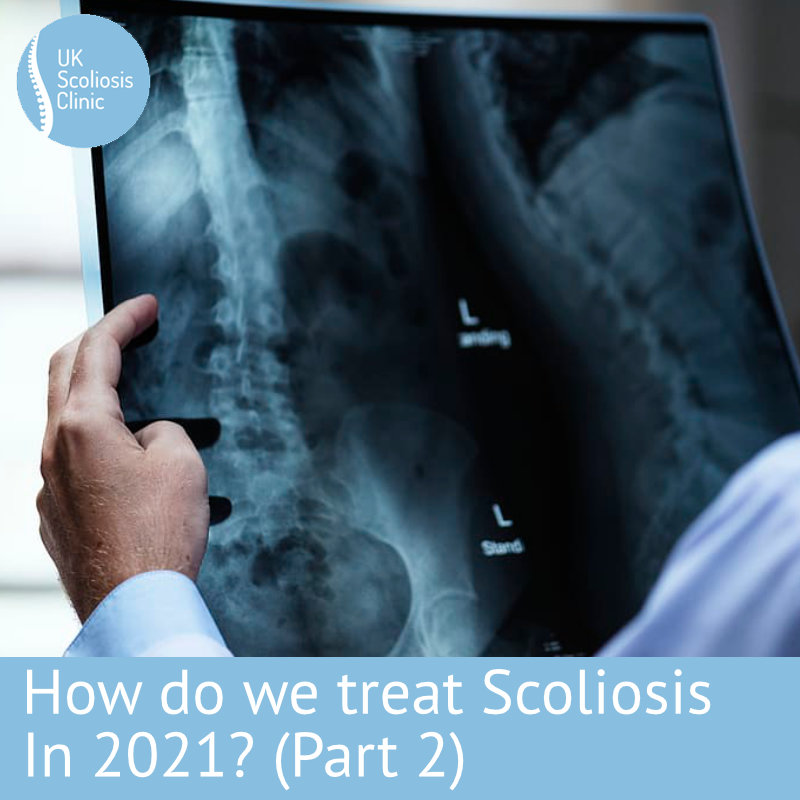
Last week we began looking at how we can best treat Scoliosis in 2021 – this week we’re continuing to look at treatments, this time in terms of exercise and physiotherapy based approaches.
Schroth Therapy
Schroth therapy is a well-established and easy to use exercise methodology which some experts consider to be the best exercise-based approach for treating Idiopathic Scoliosis. [i]
As an independent treatment, some studies have shown a reduction of cobb angle of 10-15 degrees over the course of a year[ii] – however Schroth therapy combines particularly well with bracing. When Schroth is combined with bracing superior results can often be achieved more quickly.[iii]
The Schroth method itself is comprised of more than 100 individual exercises, which are chosen and organised individually for each patient. A Schroth program usually consists of 6-8 core exercises which are specifically targeted for the curve in question. This is because the Schroth method recognises that what’s appropriate for the common 3-curve, right thoracic scoliosis, for example, would not work for the 4-curve variety.
At the UK Scoliosis clinic, we adhere to the guidelines of the Schroth Best Practice program, the most up to date development of the methodology based on recent evidence by Dr Hans-Rudolf Weiss, Grandson of Katharina Schroth and son of Christa Lehnert-Schroth. Schroth best practice incorporates the latest evidence-based approaches and includes several new methods for treating specific conditions common to scoliosis sufferers more directly than the original version.
SEAS
SEAS is the acronym for “Scientific Exercise Approach to Scoliosis”.
SEAS is an approach to scoliosis exercise treatment with a strong grounding in the most modern approaches in physiotherapy. SEAS treatment programs are usually constructed by a practitioner, who will then teach the patient their individual routine. After this, SEAS can be performed at home.
The objective of SEAS exercise is to promote self-correction of the scoliotic posture, using exercises which are often incorporated into a broader exercise program designed to improve overall function and lessen the symptoms of scoliosis.
Unlike other therapies, the SEAS methodology is constantly evolving, so seeking out a practitioner who demonstrates familiarity with the latest research is especially important.
SEAS is also used alongside bracing treatment and is especially useful for avoiding a loss of correction after the conclusion of treatment with a brace. A 2008 study showed that post-brace patients treated with SEAS experienced no loss of correction after 2.7 years.[iv]
So….Which treatment is best for me?
In most cases, the best treatment for scoliosis will be bracing – be this part time, full time or night-time based bracing. Whichever treatment you choose, be sure to opt for a clinic which offers customised one to one treatment – If you suspect scoliosis you should seek a professional consultation, but as a rough guide we would suggest:
For small curves, less than 20 degrees a scoliosis exercise program based on SEAS or Schroth might be sufficient, especially if there is a low risk of progression.
For curves over 20 degrees, or curves with a high risk of progression, bracing is the best option. Today, it is fair to say that specialised scoliosis bracing when prescribed for high-risk patients can prevent the need for surgery in most cases.[v] Research indicates that non-surgical treatment with a brace is highly effective in treating juvenile idiopathic scoliosis, whereas part-time bracing in adults significantly reduces progression of curvatures and improves quality of life.[vi]
Often exercise is combined with bracing as part of an overall treatment program – but research shows that in head to head comparison bracing is the most effective treatment in most cases. A recent study showed that over 12 months, bracing led to a mean reduction in cobb angle of 5.88 degrees, whereas exercise reduced curves by just 2.24 degrees.[vii]
[i] Steffan K, Physical therapy for idiopatic scoliosis, Der Orthopäde, 44: 852-858; (2015)
[ii] Kuru T, et al. The efficacy of three-dimensional Schroth exercises in adolescent idiopathic scoliosis: A randomised controlled clinical trial,
Clinical Rehabilitation, 30(108); (2015)
[iii] Marinela, Rață;Bogdan, Antohe, Efficiency of the Schroth and Vojta Therapies in Adolescents with Idiopathic Scoliosis. Gymnasium, Scientific Journal of Education, Sports, and Health Vol. XVIII, Issue 1/2017
[iv] Fabio Zaina et al. Specific exercises performed in the period of brace weaning can avoid loss of correction in Adolescent Idiopathic Scoliosis (AIS) patients (Winner of SOSORT’s 2008 Award for Best Clinical Paper) Scoliosis 2009 4:8
[v] Stuart L. Weinstein, Lori A. Dolan, James G. Wright, and Matthew B. Dobbs. ‘Effects of Bracing in Adolescents with Idiopathic Scoliosis’ [Results of the BrAIST Clinical Trial] N Engl J Med 2013; 369:1512-1521
[vi] Palazzo C, Montigny JP, Barbot F, Bussel B, Vaugier I, Fort D, Courtois I, Marty-Poumarat C. ‘Effects of Bracing in Adult With Scoliosis: A Retrospective Study’ Arch Phys Med Rehabil. 2016 Jun 22 . pii: S0003-9993(16)30256-8
[vii] Yu Zheng, MD PhD et al. Whether orthotic management and exercise are equally effective to the patients with adolescent idiopathic scoliosis in Mainland China? – A randomized controlled trial study SPINE: An International Journal for the study of the spine [Publish Ahead of Print]


